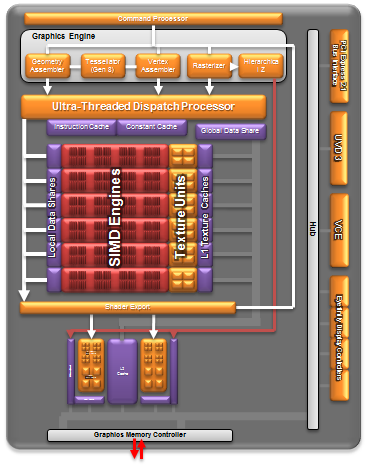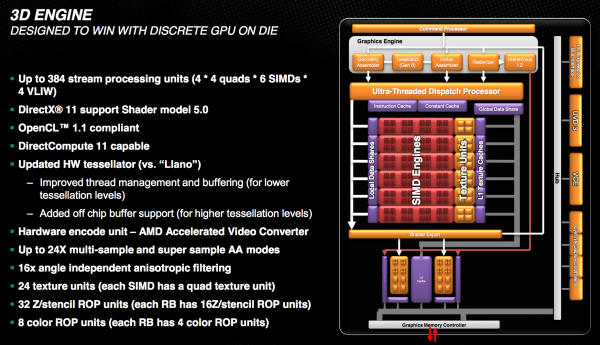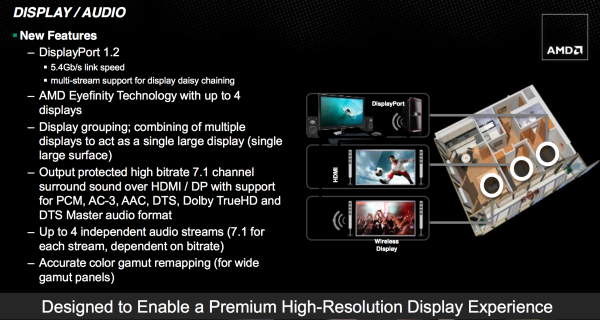The AMD Trinity Review (A10-4600M): A New Hope
by Jarred Walton on May 15, 2012 12:00 AM ESTImproved Turbo
Trinity features a much improved version of AMD's Turbo Core technology compared to Llano. First and foremost, both CPU and GPU turbo are now supported. In Llano only the CPU cores could turbo up if there was additional TDP headroom available, while the GPU cores ran no higher than their max specified frequency. In Trinity, if the CPU cores aren't using all of their allocated TDP but the GPU is under heavy load, it can exceed its typical max frequency to capitalize on the available TDP. The same obviously works in reverse.
Under the hood, the microcontroller that monitors all power consumption within the APU is much more capable. In Llano, the Turbo Core microcontroller looked at activity on the CPU/GPU and performed a static allocation of power based on this data. In Trinity, AMD implemented a physics based thermal calculation model using fast transforms. The model takes power and translates it into a dynamic temperature calculation. Power is still estimated based on workload, which AMD claims has less than a 1% error rate, but the new model gets accurate temperatures from those estimations. The thermal model delivers accuracy at or below 2C, in real time. Having more accurate thermal data allows the turbo microcontroller to respond quicker, which should allow for frequencies to scale up and down more effectively.
At the end of the day this should improve performance, although it's difficult to compare directly to Llano since so much has changed between the two APUs. Just as with Llano, AMD specifies nominal and max turbo frequencies for the Trinity CPU/GPU.
A Beefy Set of Interconnects
The holy grail for AMD (and Intel for that matter) is a single piece of silicon with CPU and GPU style cores that coexist harmoniously, each doing what they do best. We're not quite there yet, but in pursuit of that goal it's important to have tons of bandwidth available on chip.
Trinity still features two 64-bit DDR3 memory controllers with support for up to DDR3-1866 speeds. The controllers add support for 1.25V memory. Notebook bound Trinities (Socket FS1r2 and Socket FP2) support up to 32GB of memory, while the desktop variants (Socket FM2) can handle up to 64GB.
Hyper Transport is gone as an external interconnect, leaving only PCIe for off-chip IO. The Fusion Control Link is a 128-bit (each direction) interface giving off-chip IO devices access to system memory. Trinity also features a 256-bit (in each direction, per memory channel) Radeon Memory Bus (RMB) direct access to the DRAM controllers. The excessive width of this bus likely implies that it's also used for CPU/GPU communication as well.
IOMMU v2 is also supported by Trinity, giving supported discrete GPUs (e.g. Tahiti) access to the CPU's virtual memory. In Llano, you used to take data from disk, copy it to memory, then copy it from the CPU's address space to pinned memory that's accessible by the GPU, then the GPU gets it and brings it into its frame buffer. By having access to the CPU's virtual address space now the data goes from disk, to memory, then directly to the GPU's memory—you skip that intermediate mem to mem copy. Eventually we'll get to the point where there's truly one unified address space, but steps like these are what will get us there.
The Trinity GPU
Trinity's GPU is probably the most well understood part of the chip, seeing as how its basically a cut down Cayman from AMD's Northern Islands family. The VLIW4 design features 6 SIMD engines, each with 16 VLIW4 arrays, for a total of up to 384 cores. The A10 SKUs get 384 cores while the lower end A8 and A6 parts get 256 and 192, respectively. FP64 is supported but at 1/16 the FP32 rate.

As AMD never released any low-end Northern Islands VLIW4 parts, Trinity's GPU is a bit unique. It technically has fewer cores than Llano's GPU, but as we saw with AMD's transition from VLIW5 to VLIW4, the loss didn't really impact performance but rather drove up efficiency. Remember that most of the time that 5th unit in AMD's VLIW5 architectures went unused.
The design features 24 texture units and 8 ROPs, in line with what you'd expect from what's effectively 1/4 of a Cayman/Radeon HD 6970. Clock speeds are obviously lower than a full blown Cayman, but not by a ton. Trinity's GPU runs at a normal maximum of 497MHz and can turbo up as high as 686MHz.
Trinity includes AMD's HD Media Accelerator, which includes accelerated video decode (UVD3) and encode components (VCE). Trinity borrows Graphics Core Next's Video Codec Engine (VCE) and is actually functional in the hardware/software we have here today. Don't get too excited though; the VCE enabled software we have today won't take advantage of the identical hardware in discrete GCN GPUs. AMD tells us this is purely a matter of having the resources to prioritize Trinity first, and that discrete GPU VCE support is coming.















271 Comments
View All Comments
Wierdo - Tuesday, May 15, 2012 - link
I'll start recommending an integrated Intel GPU once I feel more confident about their driver support, which is more important than performance.At least now the IGP in Ivy Bridge is a decent solution for basic gaming needs, but they really need to work on their drivers, no more of that "driver update five years after product is obsolete" bs.
Spunjji - Wednesday, May 16, 2012 - link
I agree, although even that seems to have improved somewhat; at least from the base standard of "what works to begin with". Here's hoping for further progress.medi01 - Wednesday, May 16, 2012 - link
Except there is one thing which isn't visible on charts: quality. Check how horrible Intel's AF is on toms Trinity review.fumigator - Tuesday, May 15, 2012 - link
"AMD still has better drivers than Intel, but it's more like 20% better "Unluckly I had an Ivy Bridge HD4000 notebook sitting for a week, and out of 29 games, only 60% were barely playable (performance), 15% crashed, and the rest run with strange artifacts but stable enough though.
While I don't worry alot about gaming in a laptop, the true fact is that intel is way behind AMD in this, and we are not talking about 3D render quality. Oh my, you have to take a look at that and you won't doubt it a second. AMD and Nvidia renders are better.
While I still hoped more from trinity, not sure to make a judgement until I grab one and put a decent super fast ram module on it and go testing.
JarredWalton - Tuesday, May 15, 2012 - link
Could you please provide a list of the games that were unplayable and those that crashed? I'd love to be able to confirm problems.frozentundra123456 - Tuesday, May 15, 2012 - link
The gpu is "several orders of magnitude" better than intel's best? You do realize that an order of magnitude is 10x right? So how many orders of magnitude better 2, 3, 4 (100x, 1000x, 10000x). Overstate much?In fact trinity is on average what, 20-30% better than HD4000? Hardly one order of magnitude much less multiple orders of magnitude.
Overall the chip is OK, but I was actually hoping for more improvement on the GPU side. Yes, it is improved, but not enough to really make a game go from unplayable to playable.
BSMonitor - Tuesday, May 15, 2012 - link
Most laptops from that time did not use Intel's IGP on the chipset. Most had AMD or nVidia dGPU's. And these new Trinity APU's probably compete pretty closely to that.RussianSensation - Tuesday, May 15, 2012 - link
Core 2 Duo came out in 2006 not 2004.Intel doesn't sell Core 2 Duo laptops anymore in mainstream segments. They sell IVB laptops.
Are you implying that C2D user will want to upgrade to Trinity?
Most users would be far better off getting an Intel laptop with low end Kepler GPU such as GT640 than this.
Lugaidster - Tuesday, May 15, 2012 - link
Assuming equal pricing sure. But there's no way an IVB with a low end Kepler will be near a trinity laptop in terms of pricing. Most likely it will be a few hundred dollars more, which depending on the target, can make a difference.Sure you can recommend that, but not everyone will see that as worth the extra couple of hundred dollars. Considering that aside from CPU performance, a trinity notebook is roughly equal to an IVB one, with price in their favour, they can sell lots of these.
JarredWalton - Tuesday, May 15, 2012 - link
I expect we'll see dual-core IVB with Kepler going for around $800-$850 at the low end of the scale. I also expect we'll see a lot of the early Trinity laptops with A10-4600M selling for closer to $700. Hopefully I'm wrong on the Trinity side, but they did the same thing with Llano. "It's new! Charge more for it!" Not AMD's fault at all, obviously, but still irritating.